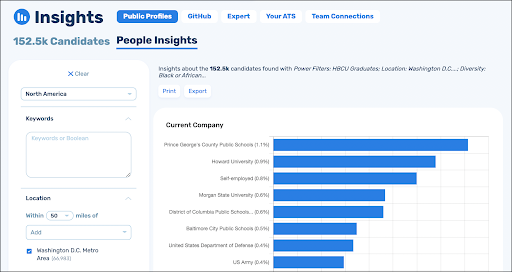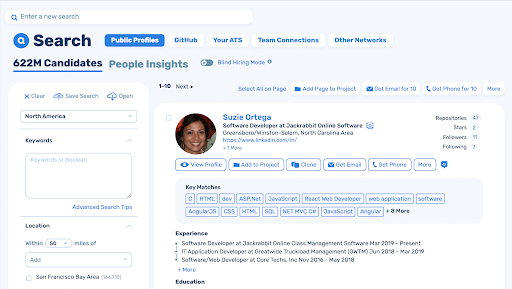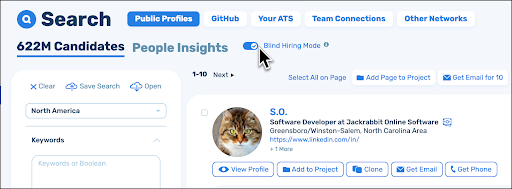Diversity, equity and inclusion are top-of-mind for today’s business leaders.
The 2020 Deloitte CEO Survey revealed that 96 percent of CEOs agree that DEI is a strategic goal. To meet that goal, 90 percent of those CEOs are prioritizing and investing in talent recruitment, development, advancement and retention, and 72 percent are prioritizing and investing in DEI data and transparency.
However, many organizations are struggling to bring new employees from different backgrounds into their workforce. According to GEM’s 2020 Recruiting Trends Report, 49 percent of talent acquisition professionals say “finding more diverse candidates to interview” is their biggest barrier to improving diversity.
SeekOut’s AI-powered Talent 360 platform helps you translate positive diversity hiring intentions into meaningful actions and results — and become the diversity champion in your company.
In this article, I’ll share how to make data your ally to meet your diversity hiring goals.
Set Realistic Diversity Hiring Targets
Too many companies set broad diversity targets for their overall workforce that aren’t based on data. If you want to make a significant difference, first gain insight into what diversity currently looks like in your organization, then benchmark that data against the talent pools you hire from.
Perhaps, you already know Black/African Americans are underrepresented in your workforce. That’s a great start, but you can get more nuanced from there.
Explore Black/African American representation in specific teams, roles and levels of your organization, and compare that data against your peers and the regions your employees are located. You can then determine the best opportunities to improve diversity in your company.

For example, if data from similar companies and your regional talent pools show a higher percentage of Black/African American data scientists than your company employs, you can set a realistic target to hire more talent from that group and plan your recruiting strategy accordingly.
Understand your Talent Pools and Create Appealing Job Descriptions
As a talent acquisition professional, you’re likely used to hiring managers having multiple must-have requirements they want included in the job description. Excessive role requirements not only restrict the number of candidates you can consider — they also prevent diverse candidates from applying.
A Hewlett Packard internal report found that men will apply for a job when they have 60 percent of the qualifications, but women tend to apply only if they meet 100 percent of the role requirements.
SeekOut gives you the data you need to have productive conversations with hiring managers about how talent pools stack up against their role requirements. You can view aggregate data on every candidates’ jobs titles, skills, employment history, educational background, diversity and more.
Using these insights, you can work with hiring managers to craft reasonable job descriptions that appeal to qualified, diverse talent — ensuring no viable candidate is left behind.
As Jim Barksdale, the former CEO of Netscape, once said, “If we have data, let’s look at data. If all we have are opinions, let’s go with mine.” Data is objective and removes opinions from conversations about role requirements. Use it to be a strategic talent advisor to hiring managers and help them see the best path toward finding their next great team member.
Create an Effective Sourcing Strategy
Now that you’ve built a job description that appeals to your talent pool, create a detailed profile of your ideal candidate and strategy for building diverse slates.
Use your talent pool insights to determine where qualified candidates are located and what it will take to make a successful hire. Will you need a relocation budget? Is remote work an option for the role? You might need to get creative and consider how to put your company in the best position to connect with diverse candidates.

You can then use keywords, Boolean strings, filters and AI matching in SeekOut to cast a wide net and build a pipeline of diverse candidates who match your profile.
Reduce Unconscious Bias in Candidate Assessments
Even the most open-minded people are influenced by biases they’re not aware they have. These unconscious biases can cause recruiters to make assumptions about a candidate based on details unrelated to the role requirements.
For example, it’s common for people to speculate about a candidate’s intelligence based on the college they attended. Even worse, talented professionals with uncommon names can be passed over for job opportunities, simply because the recruiter doesn’t want to go through the awkward experience of figuring out how to pronounce it.

With blind hiring mode in SeekOut, identifiable details such as a candidate’s name, photo and education are removed from their profile. Your sourcing team will only be able to consider skills and experience, preventing unconscious bias from influencing candidate assessments.
Discover and Engage Diverse Talent
You’ve built a pipeline of talented, diverse candidates. Now you need to get their attention and pitch the opportunity to them.
Up to this point, you’ve been strategic and data-driven. But candidate outreach requires a more humanized approach. Instead of sending the same generic, cold email to every candidate you’ve sourced, personalize the message to pique their interest. Reference what about their background impresses you, whether that be specific skills, a project they’ve contributed to or a company they’ve worked for.
Lou Adler calls this outreach approach “hiring for success.” A personalized touch helps your outreach message stand out and increases the likelihood the candidate replies and agrees to move forward in the hiring process.
DEI Starts — But Doesn’t End — with Hiring
An effective diversity hiring strategy brings people from various backgrounds into your company. However, it isn’t the be-all and end-all when it comes to DEI. If two diverse employees are exiting for everyone you hire, your recruiting efforts are ultimately meaningless.
Diversity cannot work without inclusion and diversity and inclusion cannot be sustained without belonging. The LinkedIn 2018 Global Recruiting Trends Report sums it up nicely: “Diversity is being invited to the party, inclusion is being asked to dance, and belonging is dancing like no one is watching.”
DEI is nuanced and multi-faceted. It starts with hiring people from different backgrounds but comes to life when you build a culture and workplace where people feel like they belong and can be their authentic selves at work.
Request a SeekOut demo today and learn why our AI-powered talent search engine is rated the #1 diversity recruiting tool by G2.
Authors
Anoop Gupta
Anoop is the CEO and Co-founder of SeekOut, a startup with a mission to provide companies a competitive edge in recruiting hard-to-find, diverse talent. He started SeekOut after a 20-year career at Microsoft which began with the acquisition of his first startup, VXtreme, in 1997. During his tenure, Anoop was the Corporate Vice-President of the multibillion-dollar Unified Communications group. He was TA to Bill Gates advising on technology and product strategy as a Distinguished Scientist at Microsoft Research, leading work on Telepresence and Natural User Interfaces. Prior to Microsoft, Anoop was a tenured professor at Stanford University and holds a Ph.D. in Computer Science from Carnegie Mellon University.
Recruit Smarter
Weekly news and industry insights delivered straight to your inbox.





